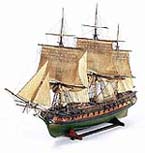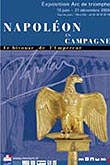| |
| |
THIS MONTH'S ARTICLE
O'Meara's account of Napoleon on the invasion of the England
Many historians were undecided as to whether Napoleon really intended to invade England, or whether the Boulogne Camp was merely an enormous (and hugely costly, it must be said) feint, designed to keep the British fleet tied down and to lull Austria into a false sense of security. On Saint Helena, Napoleon's doctor, the ambiguous Barry O'Meara, asked Napoleon this question directly. And he wrote down Napoleon's reply and sent it in a letter to the governor of Saint Helena, Hudson Lowe. This letter is today held at the British Library, bound into the manuscripts known as the Lowe Papers. Whether or not we believe that O'Meara could have memorised so long a reply, the account is astounding and reveals that Napoleon clearly saw his plan as a definite opportunity - and one that would have worked.

|
|
|
| |
DON'T MISS
Napoleon on Campaign, the emperor's bivouac, at the Arc de triomphe de l'Etoile, Paris
What better place for an exhibition on Napoleon than the highly symbolic Arc de Triomphe, commissioned by Napoleon as a monument to the courage and patriotism of the Grande Armée? And the scenography for this new exhibition was designed by Michel Albertini, the scenographer of the recently closed exhibition, 'Treasures of the Fondation Napoléon'. Included in the items on show are not only the emperor's folding campaign furniture, his writing and toilette nécessaires, but also a mobile canteen, a surgeon's bag of tools, a standard, and an flag eagle.
As the climax of the exhibition, the freize dedicated to the Grande Armée on the upper part of the arch, 42 metres from the ground, usually inaccesible to the public, will be partially displayed using full-scale photographs. This immense bas-relief is an invocation of the departure and return of the Napoleonic armies.
A fine and moving tribute to the bicentenary of the Battle of Austerlitz, open every day from 15 June to 31 December, 2005, 10am to 10pm.
Further details, click here.

|
|
|
| |
 |
 |
PAINTING IN DANGER
This painting by William Bouguereau, Napoleon III visiting the flood victims of Tarascon in June 1856, classed as a historical monument, is currently undergoing desperately needed restoration (more than six months) paid for by the town of Tarascon, despite costs of more than 22,000 euros (27,625 USD). In fact, this large painting (2m x 3m) has only been in its 'natural home' (the Tarascon Hôtel de Ville) for forty years.
William Bouguereau was born into a family of English origin living in La Rochelle in 1825. He arrived in Paris circa 1846 to study painting at the Ecole des Beaux-Arts, where he won the Premier Grand Prix de Rome in 1850 with his painting Zénobie retrouvée par les bergers (Zenobia discovered by shepherds), evidence that he followed the return to the painting of antiquity. Several of his works were exhibited at the Exposition universelle of 1855 and he received a prize. He was then honoured with commissions for the decoration of monuments (the Grand-Théâtre de Bordeaux), chapels (in Sainte-Clothilde, in Saint-Augustin and in Saint-Vincent-de-Paul in Paris) or private city mansions (such as that of Pereire). At the same he signed a contract with a art dealer, which unfortunately led him to excel more in quantity than quality. Despite the fact his name became a byword for excessive attention to detail (critics of the time coined the expression «bouguereauté» and Zola spoke of his works as the «triumph of tidiness in painting»), nevertheless Bouguereau was much appreciated by those in power, and he was to receive many commissions and rewards (he was made Chevalier de la Légion d'honneur in 1859).
In 1856, in his journey along the banks of the Rhône and the Loire ravaged by floods, Napoleon III had himself accompanied by photographers and the painter Bouguereau, commissioned to immortalise the imperial sympathy.
This year is the centenary of Bouguereau death, 19 August, 1905.© DR
For a web page on William Bougeureau, click here

|
|
|
| |
NEW STUDIES ON NAPOLEON'S DEATH
After studies by Swiss researchers and their conclusions that Napoleon died of cancer, Dr Kintz has just published the results of his new study on the emperor's hair: high concentration of arsenic, an organic arsenic, of endogenous origin. Dr Kintz however concludes that: "our analysis is irrefutable as to the arsenic used and the intoxication, but it does not however explain the origin of that arsenic". In other words, there is no suspect and no serious historic discussion as to a motive to confirm the theory of the deliberate poisoning of the emperor on Saint Helena...
Source: Le quotidien du médecin, 7 juin 2005.

|
|
|
| |
200 YEARS AGO
Italy
Napoleon left Milan on 21 Prairial, An XIII (10 June, 1805). He arrived in Brescia the following day and stayed there for several days.
Rumors...
A report of the Police prefecture of 23 Prairial (12 June) noted discussions taking place at certain public meetings: "They say that the news from Italy, which came via a courrier sent by the Prince Eugène, was that His Majesty the Emperor had been prevented by His Excellency the Maréchal Berthier from performing a planned visit to a town near Milan. The Maréchal had been informed that an attempt would be made on the Emperor's life en route. They added that His Majesty had wished to know how far the rumours were founded and had consequently invited several people join him in his carriage, adding to this a strong escort; in fact the carriage did indeed receive a hail of bullets, and several people were killed, including the Mameluk Roustam."
Society
The periodical, Le Journal des débats dated 22 Prairial (11 June) announced that the government had just sent to all prefects "boxes of medicines made up by the central pharmacy of the Hôpitaux de Paris. The medicines delivered to the prefectural arrondissements are so as to be able to provide free medical assistance to the poor in the countryside during epidemics. The medicines are to be administered by a doctor appointed ad hoc and epidemic doctors, and these are to be overseen by the administrative authorities. Each box contains twenty-five medicinal substances, to be renewed every year."
Wishing you an excellent, Napoleonic, week!
Peter Hicks
Historian and Web editor
Interested in the work of the Fondation Napoléon? Why not participate, either generally or in a specific project, by making a donation.
© this Napoleon.org weekly bulletin is published by the Fondation Napoléon. Reproduction or all or part of this bulletin is forbidden, without prior agreement of the Fondation Napoléon.

|
|
|
|
|
|
|
|
|
|
THIS WEEK
SNIPPETS
- 'New' Napoleonic novel by Alexandre Dumas - Le Chevalier de Sainte-Hermine
PRESS REVIEW
- The Member's Bulletin of the Napoleonic Society of America, Bulletin 79, Spring 2005
JUST PUBLISHED
- Sir Charles Oman, A History of the Peninsular War, vols 5 and 6
WHAT'S ON
- Exhibition: Nelson and Napoleon, National Maritime Museum, London, UK
- Exhibition: Il rifugio di Venere. La Villa Paolina Bonaparte, Viareggio, Italy
- Conference: War at Sea in the age of Nelson, The Trafalgar Bicentennial Conference, Christ Church, Oxford, UK
- Conference: Europe at War: the Trafalgar campaign in context, Senate House, London University, UK
- Conference: The Battle of Trafalgar Conference, at Action Stations, Portsmouth Historic Dockyard, UK
- For Napoleonic and Nelsonian 2005 bicentenaries, watch our 2005 bicentenaries page
THE MONTHLY TITLES
- This month's book: David Miller, The Duchess of Richmond's Ball, 15 June, 1815
- This month's painting: The Prince impérial on his poney, by Mayer and Pierson
- This month's article: O'Meara's account of Napoleon on the invasion of the England
- In the Collectors Corner, Napoleon Ist as legislator, by Eugène Guillaume
Got a problem with a link in the letter? Try the homepage
<<
|
|



